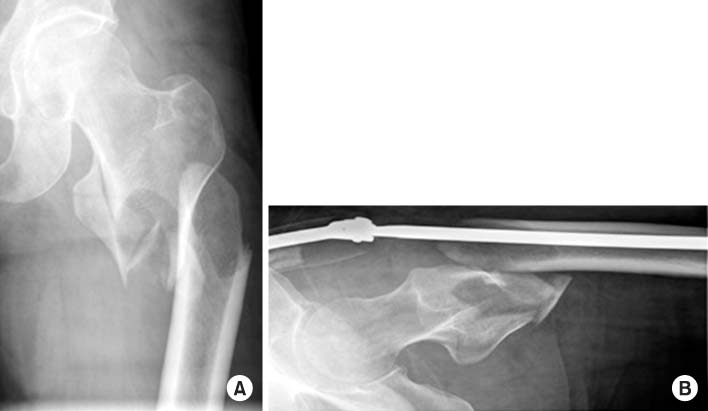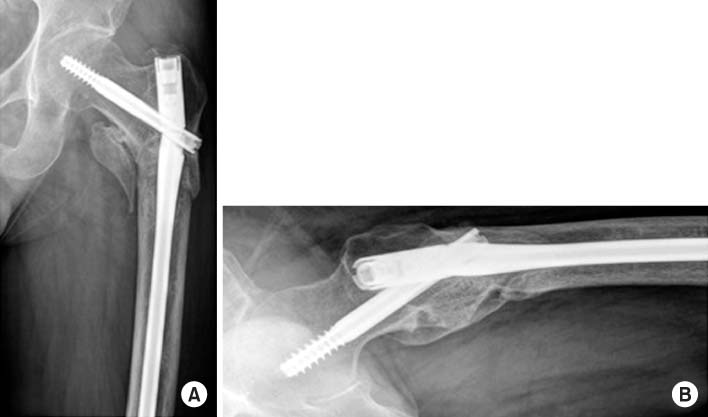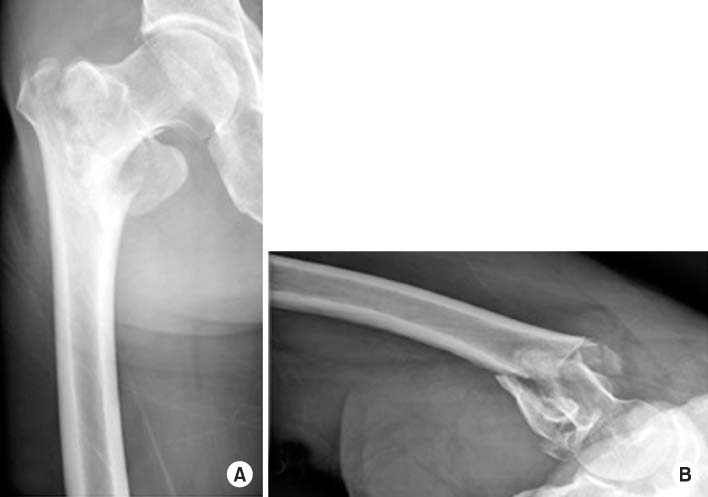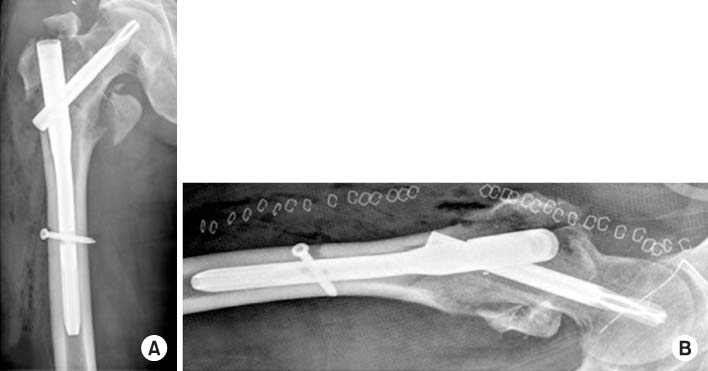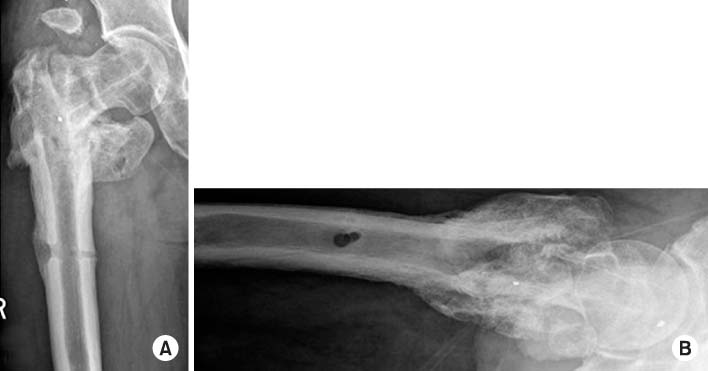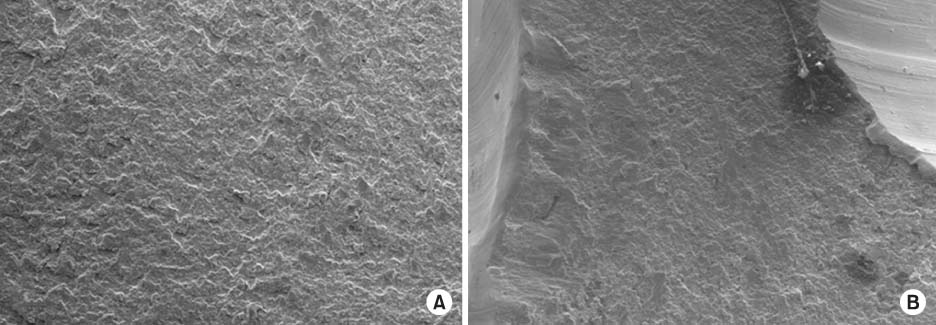J Korean Fract Soc.
2016 Jan;29(1):42-49. 10.12671/jkfs.2016.29.1.42.
Breakage of Cephalomedullary Nail Used in the Treatment of Proximal Femur Fractures: Case Report
- Affiliations
-
- 1Department of Orthopaedic Surgery, Wonkwang University School of Medicine, Iksan, Korea.
- 2Department of Orthopaedic Surgery, Presbyterian Medical Center, Seonam University School of Medicine, Jeonju, Korea. bhinder@naver.com
- KMID: 2183764
- DOI: http://doi.org/10.12671/jkfs.2016.29.1.42
Abstract
- Internal fixation using a cephalomedullary nail as treatment for proximal femur fracture has recently been popular for early ambulation and rehabilitation. However metal breakage at the lag screw insertion site was reported due to non-union, delayed-union, and early weight bearing. In our orthopedic department, we experienced 2 cases of nail breakage at the lag screw insertion site, therefore we report on evaluation of the cause of metal failure and prevention of complications with literature review.
Keyword
Figure
Cited by 1 articles
-
Breakage of the Tail Portion of the Lag Screw during Removal of Proximal Femoral Zimmer Natural Nail: Report of Two Cases with Technical Notes
Asep Santoso, Ik-Sun Choi, Kyung-Soon Park, Taek-Rim Yoon
Hip Pelvis. 2017;29(3):199-203. doi: 10.5371/hp.2017.29.3.199.
Reference
-
1. Bridle SH, Patel AD, Bircher M, Calvert PT. Fixation of intertrochanteric fractures of the femur. A randomised prospective comparison of the gamma nail and the dynamic hip screw. J Bone Joint Surg Br. 1991; 73:330–334.
Article2. Leung KS, So WS, Shen WY, Hui PW. Gamma nails and dynamic hip screws for peritrochanteric fractures. A randomised prospective study in elderly patients. J Bone Joint Surg Br. 1992; 74:345–351.
Article3. Kasimatis GB, Lambiris E, Tyllianakis M, Giannikas D, Mouzakis D, Panagiotopoulos E. Gamma nail breakage: a report of four cases. J Orthop Surg (Hong Kong). 2007; 15:368–372.
Article4. Vanderschot P, Vanderspeeten K, Verheyen L, Broos P. A review on 161 subtrochanteric fractures: risk factors influencing outcome: age, fracture pattern and fracture level. Unfallchirurg. 1995; 98:265–271.5. Sadowski C, Lübbeke A, Saudan M, Riand N, Stern R, Hoffmeyer P. Treatment of reverse oblique and transverse intertrochanteric fractures with use of an intramedullary nail or a 95 degrees screw-plate: a prospective, randomized study. J Bone Joint Surg Am. 2002; 84:372–381.
Article6. Curtis MJ, Jinnah RH, Wilson V, Cunningham BW. Proximal femoral fractures: a biomechanical study to compare intramedullary and extramedullary fixation. Injury. 1994; 25:99–104.
Article7. Iwakura T, Niikura T, Lee SY, et al. Breakage of a third generation gamma nail: a case report and review of the literature. Case Rep Orthop. 2013; 2013:172352.
Article8. Valverde JA, Alonso MG, Porro JG, Rueda D, Larrauri PM, Soler JJ. Use of the Gamma nail in the treatment of fractures of the proximal femur. Clin Orthop Relat Res. 1998; (350):56–61.
Article9. Zafiropoulos G, Pratt DJ. Fractured Gamma nail. Injury. 1994; 25:331–336.
Article10. Alvarez DB, Aparicio JP, Fernández EL, Múgica IG, Batalla DN, Jiménez JP. Implant breakage, a rare complication with the Gamma nail. A review of 843 fractures of the proximal femur treated with a Gamma nail. Acta Orthop Belg. 2004; 70:435–443.
- Full Text Links
- Actions
-
Cited
- CITED
-
- Close
- Share
- Similar articles
-
- Breakage of a Lag Screw of Cephalomedullary Nail: A Technique of Removal
- Outcomes of Combined Neck and Trochanter Fractures of the Femur Treated with Cephallomedullary Nail in Elderly
- New Approach in the Treatment of Intertrochanteric Fracture Using a Cephalomedullary Nail
- Removal Methods for Broken Proximal Femoral Nails Using Ball Tip Guide Wire: Technical Note and Two Cases Report
- Segmental Breakage of Distal Interlocking Screw Complicating removal of broken nail: A Case Report

